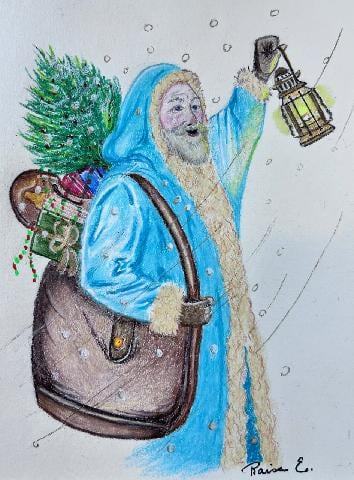“Saint Nicolas in Blue” Colored Pencil by Raisa Estrada
Yes, Virginia, there was a Santa Claus, but he was Christian, kinder, and more courageous than the current caricature of commercialized Christmas time. In this article I endeavor to summarize what I found to be the few fairly firm historical facts in stories about Nicholas of Myra who lived from about 260-335 AD. Then I will state five lessons we can learn from his life.
The most important fact about the historical record of Nicholas or any other person of ancient times except for Jesus Christ is that it is extremely skimpy compared to the vast, voluminous, very well attested and early evidence of the life of Christ. There are now existing 20-25,000 ancient handwritten manuscripts of the New Testament, 10-15 written within 100 years of its completion, as well as numerous ancient writings quoting portions of it.1 For the life of Nicholas of Myra there are two bios, written about 400 and 600 years after he lived. There are a few other documents corroborating his life.
Nicholas was born and was the only child of Christian parents in Patara of Lycia, now southern Turkey. His name means “victory for the people”. Being brought up in the church, he never strayed from it. In his young life he learned and practiced moral integrity including sexual purity, compassion, and humility.2 He was educated for 11 years in schools. His parents died when he was about 18 and left him considerable wealth. Nicholas sought God’s direction in the Scriptures for his life and use of wealth.
One of Nicholas’ neighbors suddenly fell into great poverty and distress. This father had three beautiful daughters. To keep from starving, this man resolved to sell his daughters into prostitution. Led by the Lord, Nicholas put some gold coins in a small moneybag, tied the string and at night tossed it through an open window into the man’s house. The next morning the family praised God amid tears of joy. This was just the amount for a dowry, and the father used it get his eldest daughter married. Later Nicholas secretly repeated his nocturnal giving twice more for the dowries of the remaining two daughters. After receiving the second gift, the father received salvation and prayed to God.3 After the third gift came, the father ran after and caught Nicholas, who made him promise never to reveal his identity.
At about age 30, Nicholas walked into the house of God in the neighboring city of Myra. Just before this, the bishops of the region were meeting and prayed that God would lead them to choose the next bishop of Myra. A senior bishop received a vision to go to the house of God and “take the first person to enter and ordain him as bishop. His name will be Nicholas.”4 As bishop, Nicholas wore the simple black garb of the peasants. “He served God above all else and executed the ministry of Christ and the church with diligence and prayerfulness.”45
Soon after becoming bishop, Nicholas was arrested by Romans on religious charges without just cause. He was tortured for his faith, but he refused to renounce Christ or hand over Scriptures to be burned. He bore the wounds and scars the rest of his life. Released, he served most of his tenure as bishop under governmental persecution until Constatine became emperor in 324.
In 325 Constantine called a council of all bishops at Nicaea. Nicholas attended and upheld the apostolic faith in God Father, Son and Holy Spirit in opposition to the heresy of Arius who taught that Jesus was not God but was created. At the council Arianism was soundly refuted. The council wrote the famous Nicene Creed affirming the “Lord Jesus Christ, the Son of God,…begotten, not made, being of one substance with the Father…”. With patience and kindness, Nicholas wrote a series of letters to a monk who was an Arian sympathizer and persuaded him of the truth of Christ.
As bishop, Nicholas served as not only a pastor but also a civic preacher and an arbiter of justice. He led the removal of the pagan religion of Artemis from his region by preaching Christ throughout his diocese.
In 331, bad weather forced a convoy of Roman military ships to land at the port of Myra. The troops were permitted to fan out in the city to seek food and entertainment. When some local criminals disguised themselves as soldiers to loot and pilfer, a riot broke out. Nicholas, then about 70, went to the plaza, quieted the mob and conferred with the troops’ three commanding officers. Just then, Nicholas was informed that the governor was about to execute three innocent men. Nicholas ran to them, “yanked the sword from the executioner, and threw it to the ground. Dramatically, he untied the prisoners’ hands and set them free.”6 As bishop, Nicholas was legitimate in doing so under the Constitution. Then Nicholas burst into the Praetorium and chastised the governor, who had been bribed to execute these innocent men. The three Roman generals had followed him and witnessed all this.
Soon, these generals found themselves in a similar fix. Also, as a result of a bribe, they were accused of treason to the emperor and sentenced to death. They called out to the God of Nicholas to save them. The night before their planned execution, Constantine had a dream of a man he didn’t know named Nicholas ordering him to free the three unjustly imprisoned generals. When he awakened, he called for them, and they told him of Nicholas of Myra and that they had prayed to his God. The emperor then freed them.
Several legends have been linked to Nicholas of Myra. Some are erroneously attributed to him whereas they were actually linked to another Saint Nicholas of Sion who lived about 200 years later. Many of these legends are obviously fantastic.
Lessons learned from the life of Saint Nicholas of Myra are the following.
- Plan to give of what you have to meet real need.
- Give anonymously.
- Be bold and courageous in speaking out for justice.
- Act for mercy when you can.
- Persevere in your faith in and walk with Christ.
Notes
1 Paul D. Wegner, “The Reliability of the New Testament Manuscripts,” in The ESV Study Bible, (Wheaton, IL: Crossway Bibles, 2008), p. 2587
2 Adam English, The Saint Who Would Be Santa Claus (Waco, TX: Baylor University Press, 2012), p. 46.
3 English, p. 61.
4 English, p. 86.
5 English, p. 92.
6 English, p. 132.

Tom Giesecke Author. Grew up in Olympia, WA, where he received Christ at age 15. He graduated from Davidson College, NC, and Emory University School of Medicine, Atlanta, GA. After his medical internship at the National Naval Medical Center Bethesda, MD, he trained and served as a U.S. Navy Flight Surgeon for four years. Following residency training, he served thousands of people as a Board-certified Family Physician for more than thirty-five years. Learning of God’s love motivates Tom to daily search the Scriptures for more. Tom has led Bible studies for many years and enjoys sharing “the word of God, and recently publishing a book (find in the Sonrise Bookstore and Amazon) on the grace of God: Gracious Goodness.” Reach Tom at tomgiesecke@comcast.net

Leave a Reply